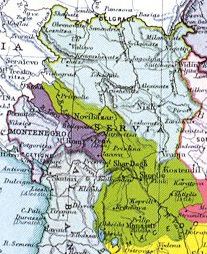End date 1941 | ||
 | ||
The colonisation of Kosovo was a programme implemented by the Kingdom of Yugoslavia during the interwar period (1918–1941) with the aim of altering the ethnic population balance in the region where Albanians formed an ethnic majority. During the colonisation period, between 60,000 and 65,000 colonists, of whom over 90% were Serbs, settled on the territory of the former Kosovo Vilayet captured from the Ottoman Empire in 1912. Along with the Serb colonisation, a policy of forced migration of ethnic Albanians was attempted, enlisting the participation of Turkey.
Contents
Colonisation process
Some Serb colonisation of Kosovo took place during the Balkan Wars (1912-1913). Government sponsored colonisation was initiated in 1920 when the assembly of the Kingdom of Yugoslavia passed the Decree on the Colonisation of the Southern Provinces of Yugoslavia, while the second began in 1931, when the Decree on the Colonisation of the Southern Regions was issued. Former soldiers and chetniks were offered incentives to settle in Kosovo, although this phase of the colonisation is considered unsuccessful because only 60 to 70 thousand people showed a willingness to become settlers, of whom many failed to follow through.
From 1918 to 1921, expulsions of the Albanian population reduced its numbers from around one million to about 439,500. In the 1930s, Yugoslavia signed treaties with Turkey (which were never implemented) providing that Turkey, with Islam as the major religion, would accept expellees; Albanians have a Muslim community, although highly secularized. One treaty signed in 1935 undertook the transfer of about 200,000 Albanians while a second treaty signed in 1938 undertook the transfer of 40,000 Albanian families.
The table shows the total number of registered settlers in each Kosovo county:
In 1937, a Serbian nationalist intellectual, Vaso Čubrilović, who had been one of the plotters of the assassination of Austrian Archduke Franz Ferdinand, proposed the expulsion of all Albanians:
In our examination of colonisation in the south, we hold the view that the only effective means of solving this problem is the mass expulsion of the Albanians. Gradual colonisation has had no success in our country, nor in other countries for that matter. If the state wishes to intervene in favour of its own people in the struggle for land, it can only be successful by acting brutally.
Aftermath and legacy
During the Second World War, parts of Kosovo was annexed into an Albania under fascist rule. There ensued mass killings of Serbs and an exodus of tens of thousands of Serbs. Carlo Umiltà, an aide to the leader of the Italian military forces in Kosovo, recounted that Albanians were out to exterminate all Slavs and told of several events where horrified Italian troops were forced to fire on their Albanian allies to halt massacres of Serbs.
After World War II, Josip Broz Tito abolished the colonisation programme in order to avoid ethnic and religious conflict. Initially, Serbs who had departed were not allowed to return. After protests by ethnic Serbs, this ban was revoked and a minority of the departed returned to Kosovo. Eventually the ethnic balance of the population increased from 75 percent Albanian to 90 percent.
During the rise of Serbian nationalism in Yugoslavia in the 1980s and 1990s, revisionist books were published promoting the opinion that Serbs had been the sole victimised ethnicity in Kosovo during the existence of Yugoslavia. Among these works, Knjiga o Kosovu [“A book on Kosovo”] by an eminent professor, Dimitrije Bogdanović, in 1985 would be especially influential one that would be influential on resurgent Serb nationalism among the Serb intelligentsia. During Operation Storm of August 1995 the total number of Serb refugees is reported to be up to 200,000 by international media, and organisations. In the late 1995, the Serbian government took the decision to settle up to 20,000 Serbian refugees from Krajina in Kosovo in an attempt to trip the ethnic balance there. Around 10,000 Serb refugees from Krajina were already settled in Kosovo before. Many countries reacted negatively to this plan and urged the Serbian government to cease forced resettlement of Krajina Serbs to Kosovo.
